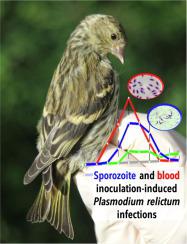International Journal for Parasitology ( IF 3.7 ) Pub Date : 2020-08-31 , DOI: 10.1016/j.ijpara.2020.05.015 Vaidas Palinauskas 1 , Elena Platonova 2 , Rita Žiegytė 1 , Andrey Mukhin 3

|
Complex experimental studies of vertebrate host, vector, and parasite interactions are essential in understanding virulence, but are difficult or impossible to conduct if vector species are unknown. Subinoculation of erythrocytic meronts of avian malarial parasites into susceptible hosts can avoid this problem, but this approach omits early exoerythrocytic stages, e.g. cryptozoites and metacryptozoites, that normally develop from sporozoites. A fundamental question that has remained unanswered is whether blood stage and sporozoite-induced malarial infections lead to differences in the dynamics of parasitemia in acute infections, patterns of parasite development, and host mortality. Here we demonstrate in a Carduelis spinus – Plasmodium relictum (genetic lineage pSGS1) system that experimental infections using inoculation of infected blood and using mosquito bite show similar peaks of parasitemias, but some measures of parasite development in the vertebrate host differ. Infected birds from all groups show decreased activity during the peak of parasitemia. There is no doubt that experimental infections using vectors provide the most precise information about the development of a parasite and its virulence in the host, but experimental infections using blood stages demonstrate similar parasitemias and effects on the host. These results are important for further experimental research of malarial parasites, especially studying avian Plasmodium parasites with unknown vectors.
中文翻译:

实验感染的雀科动物的血液阶段动态和子孢子诱导的疟疾感染。
脊椎动物宿主、载体和寄生虫相互作用的复杂实验研究对于了解毒力至关重要,但如果载体种类未知,则很难或不可能进行。将禽疟原虫的红细胞分种亚接种到易感宿主中可以避免这个问题,但这种方法忽略了早期的红细胞外阶段,例如隐孢子和隐孢子,它们通常由子孢子发育而来。一个仍未得到解答的基本问题是,血液阶段和子孢子诱导的疟疾感染是否会导致急性感染中寄生虫血症的动态、寄生虫发育模式和宿主死亡率的差异。在这里,我们在Carduelis spinus – Plasmodium relictum 中演示(遗传谱系 pSGS1)系统,使用感染的血液接种和使用蚊虫叮咬的实验感染显示出相似的寄生虫血症峰值,但脊椎动物宿主中寄生虫发育的一些措施不同。在寄生虫血症的高峰期,所有组的受感染家禽都表现出活动性下降。毫无疑问,使用载体的实验性感染提供了关于寄生虫在宿主中的发育及其毒力的最精确信息,但使用血液阶段的实验性感染证明了类似的寄生虫血症和对宿主的影响。这些结果对于疟疾寄生虫的进一步实验研究具有重要意义,特别是研究具有未知载体的禽疟原虫寄生虫。











































 京公网安备 11010802027423号
京公网安备 11010802027423号